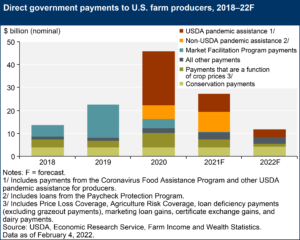President Donald Trump late Wednesday signed into law a measure to end the longest-ever government shutdown after 43 days, fully fund USDA and FDA for fiscal 2026, and end a…
Conservation Title Kicks Off 2023 Farm Bill Debate in House Ag Subcommittee Hearing
Background
Late last month, the Congressional Research Service (CRS) released an update titled, “Farm Bill Primer: Conservation Title.”
CRS explained that,
The conservation title of a farm bill generally contains reauthorizations, amendments, and new programs that encourage farmers and ranchers to voluntarily implement resource-conserving practices on private land.
“Starting in 1985, farm bills have broadened the conservation agenda to include addressing multiple natural resource concerns. Although the number of conservation programs has increased and techniques to address resource problems continue to emerge, the basic approach has remained unchanged: provide financial and technical assistance to implement conservation systems supported by education and research programs.
“As Congress begins the process of authorizing the next farm bill, areas of possible interest in the conservation title may include funding for programs, climate strategies for the agricultural sector, the backlog of unfunded applications, compliance provisions, and program flexibility.”

Last month’s report noted that, “The conservation title is one of the larger non-nutrition titles of the farm bill, accounting for 7% of the total projected 2018 farm bill cost, or $60 billion of the total of $867 billion in 10-year mandatory funding it authorized (FY2019-FY2028). Spending for agricultural conservation programs generally has increased from $2.3 billion in FY2002 to over $5 billion in total outlays in FY2020. Annual outlays beyond the 2018 farm bill’s expiration (FY2023) are projected to plateau above $6 billion (Figure 1, below), assuming programs are reauthorized with no changes.”

And in a 2022 farm sector income forecast update on Friday, the USDA’s Economic Research Service pointed out that, “Conservation payments from the financial assistance programs of USDA’s Farm Service Agency (FSA) and Natural Resources Conservation Service (NRCS) are expected to be $4.2 billion in 2022, up 7.3 percent from 2021.

“The increase in conservation payments is due to slight increases in Conservation Reserve Program (CRP)-enrolled acres and an increase in payments from NRCS programs.”
House Agriculture Subcommittee Hearing
With this brief background in mind, the House Agriculture Subcommittee on Conservation and Forestry held a hearing last week titled, “A 2022 Review of Farm Bill Conservation Programs.”
Timothy Eggert reported last week at FarmWeekNow that, “Federal lawmakers formally launched 2023 farm bill discussions Wednesday, pressing the heads of two USDA conservation agencies to streamline existing programs and deploy more agency staff at the local level.
“Farm Service Agency (FSA) Administrator Zach Ducheneaux [prepared testimony] and Natural Resources Conservation Service (NRCS) Chief Terry Cosby [prepared testimony] fielded nearly two hours of questions from members of the House Agriculture Committee’s Subcommittee on Conservation and Forestry.
“Most of the panel’s Republican members pushed Ducheneaux and Cosby to explain the environmental and economic links between enrolling in federally-funded conservation programs and combatting climate change, while Democratic members largely asked how the two agencies might use $29 billion in conservation funding proposed in the Build Back Better [BBB] bill.”

Eggert added that, “Members found common ground, however, in expressing the need to cut red tape at the agencies to streamline the disbursement of funds and boosting staffing in local agency offices.”
And DTN writer Todd Neeley reported last week that, “Though the Build Back Better Act remains stalled in Congress, the top Republican on the House Agriculture Committee questioned Wednesday whether USDA would be ready to dole out what would be a dramatic increase in conservation funds if the bill eventually passed.”
The DTN article stated that, “The [BBB] legislation includes a $27.1 billion increase for USDA conservation programs across 10 years. Among the conservation details, a provision in the bill would pay farmers $25 an acre to grow cover crops.”
“Cosby said his department would be ready if more federal conservation dollars are made available,” the DTN article said.
Neeley added that, “Rep. Abigail Spanberger, D-Va., the chairwoman of the subcommittee [opening statement], credited NRCS for its work on climate-smart agriculture. She also called on her fellow House members to follow the Senate’s lead and pass the Growing Climate Solutions Act. The bill, which would establish a carbon-credit certification program at USDA, passed the Senate 92-8 last summer. Spanberger noted the bill is backed by a long list of agricultural groups, some environmental groups and Fortune 500 companies.”





